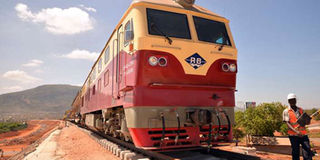Kenya should now concentrate on Lapsset, the bigger picture

Ongoing construction works of the standard gauge railway at Voi Taita Taveta County on March 15, 2016. The project will be essential in promoting the economy. PHOTO | SALATON NJAU | NATION MEDIA GROUP
What you need to know:
- The Lapsset Corridor was not designed to be just another Thika highway. It was to be a multi-component project with great premium, delivering in its wake a massive seaport.
- One of the most urgent steps was to create a Kenyan-based special purpose vehicle to coordinate project activities in line with Ethiopia, South Sudan, and Uganda. Kenya must show leadership.
- Thousands of opportunities abound — from development to securing the length and breadth of the corridor — presenting Kenya with a winning strategy.
It was a show of political maturity to see President Uhuru Kenyatta and his Northern Corridor counterparts walk hand in hand at their review meeting in Kampala.
If there were any sour grapes, then they did a good job of hiding it, especially after Uganda pulled the rug from under Kenya’s feet and handed the pipeline deal to Tanzania’s Dr John Magufuli.
It will be remembered that the Kenya-Uganda agreement on the pipeline had been in the locker since 2012, when discussion on the building of the Lamu Port-South Sudan-Ethiopia Transport (Lapsset) Corridor picked pace.
Let us put this in context. Even with its estimated generation of over 15,000 jobs during and after its construction, it must be noted that the Ugandan pipeline was to be only a relatively small component of the larger Lapsset corridor.
Its “loss’’ to Tanzania, however, brings to mind other big projects that started with a big bang but have over time lost their thunder. The Konza technopolis easily comes to mind.
At the time of its groundbreaking in January 2013, many global names showed an interest in it, including tech giants Google, Apple, IBM, Microsoft, and Toshiba.
The potential and promise of Konza were big: first class infrastructure, over 200,000 jobs, picturesque suave young men in jeans and polo shirts strolling on the sprawling streets of our version of Seattle’s Silicon Valley aka “Silicon Savannah” with gizmos in their hands, dreaming and streaming their latest apps.
However, two managing directors later and over three years since the groundbreaking, not much is heard of it except for a court case relating to a land transaction.
GREAT OPPORTUNITY
The Lapsset Corridor was not designed to be just another Thika highway. It was to be a multi-component project with great premium, delivering in its wake a massive seaport, multiple airports, a standard gauge railway, and multiple highways that would link the Kenyan coast to the hinterland of Ethiopia, South Sudan, and the Ugandan oil wells.
It is huge even by regional standards, so much so that in January 2015, the African Union admitted Kenya as the ninth member of the AU Presidential Infrastructure Championship Initiative, recognising Lapsset as one of the key regional infrastructure projects that would help facilitate intra-Africa trade.
It is in line with this that Kenya will be hosting the second high-level meeting of the Global Partnership for Effective Development Coordination this year, the first time to be held in Africa.
Folks, we will need to report progress on Lapsset.
One of the most urgent steps was to create a Kenyan-based special purpose vehicle to coordinate project activities in line with Ethiopia, South Sudan, and Uganda. Kenya must show leadership.
Analysts agree that there cannot be a shortage of financiers given the attractiveness of the corridor.
If it takes off, the spiral effect on job creation would be immense.
Its impact on devolving labour and skills would be invaluable and would help deal with the simmering undercurrents of marginalisation that give rise to radicalisation of youth.
Thousands of opportunities abound — from development to securing the length and breadth of the corridor — presenting Kenya with a winning strategy.
This is even before you factor in access to Ethiopia’s and South Sudan’s 120 million-strong market.
STAY ON COURSE
Uganda may now look more attractive, given the current turmoil in South Sudan.
However, daybreak for Juba will arrive. Let us be there with a pipeline when that day dawns.
One thing is clear though. Delivering on big impact projects hinges on a big champion, a big driver, a “bulldozer” of sorts, to drive through the fog of political and vested-interest blackmail and attract the big investors because they need the assurance that red tape will be sliced through and bureaucracy overcome.
As the champion of Kenya’s big things, President Kenyatta must not lose sight of the big picture.
He must lead from the front to deliver those projects that speak of Kenya’s leadership in the region.
Mr Kiraka is a consultant for Comesa and the executive director of RiimNet-Africa. [email protected]



